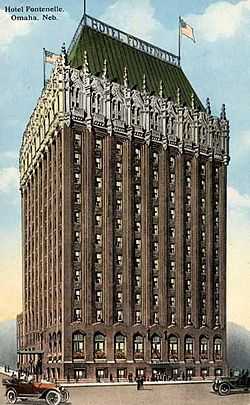Hotel Fontenelle
| Hotel Fontenelle | |
|---|---|
 The Hotel Fontenelle in Downtown Omaha. | |
| General information | |
| Architectural style | Late Gothic Revival |
| Town or city | Omaha, Nebraska |
| Country | United States |
| Construction started | 1914 |
| Completed | 1915 |
| Demolished | 1983 |
| Cost | $1,000,000 |
| Client | Gurdon W. Wattles |
| Design and construction | |
| Architect | Thomas Rogers Kimball |
Hotel Fontenelle was an upscale hotel located at 1806 Douglas Street in downtown Omaha, Nebraska. Designed by noted architect Thomas Rogers Kimball in the Late Gothic Revival style, it was built in 1914 and demolished in 1983. It was named for Logan Fontenelle, a well-known chief of the Omaha Tribe.[1]
History
The Fontenelle was opened in 1915. Costing $1,000,000 to build, the building was designed by Kimball for the Douglas Hotel Company and its president, Gurdon W. Wattles. Originally fifteen stories, it was later expanded to 18, with a main entrance on Douglas Street. The building had 350 guest rooms decorated in an English style, with marble floors, mahogany paneling and richly decorated lobbies, dining rooms and hallways throughout. The main banquet room featured five crystal chandeliers, lighting seating for as many as 500 guests.[2]
The center of Omaha society, the hotel was the site of numerous civic events, weddings and conventions. These included the founding of the Girl Scout movement in Omaha.[3] a national women's bowling tournament,[4] and lectures by Willa Cather and other nationally known authors.[5] Its restaurants included the Bombay Room, Black Mirror Room and King Cole Room.
The Fontenelle was operated by the Douglas Hotel Company until 1920, after which it was acquired by hotel magnate Gene Eppley, becoming the flagship of his Eppley Hotel Company, which in the 1950s was the largest privately held hotel company in the US. Eppley operated 22 units in six states and lived in the Fontenelle after buying it in 1920, and died there in 1958.
Eppley sold his hotel empire to Sheraton Hotels, for thirty million dollars in 1956. It was the second largest hotel sale in United States history.[6] The hotel became the Sheraton-Fontenelle and continued to be a popular destination for social events. Sheraton sold the hotel in 1968, at which time it became independent, reverting to the Fontenelle name. The hotel was headquarters for Senator Robert F. Kennedy's 1968 Democratic Nebraska primary campaign.
However, as the city grew westward, the hotel faded in popularity and was closed in 1970, due also to the structure's deteriorating condition. Many attempts were made to redevelop the Fontenelle as it stood empty over the next thirteen years,[7] but it was eventually demolished in 1983.[8] The site is now the parking lot of the Roman L. Hruska Federal Courthouse.
Notable guests
The Fontenelle hosted many celebrities and politicians through the years, including President Harry S. Truman,[9] who was a personal friend of Gene Eppley. Senator John F. Kennedy and his wife Jacqueline stayed there during his campaign for the 1960 Presidential election.[10]
See also
- History of Omaha
- Yule marble
References
- ↑ Gerber, K. and Spencer, J.S. (2003) Architecture for the Ages. Landmarks, Inc. p. 35.
- ↑ Gerber, K. and Spencer, J.S. (2003) Architecture for the Ages. Landmarks, Inc. p. 35.
- ↑ History, Great Plains Girl Scouts Council. Retrieved 2/2/08.
- ↑ Congress, Inc. Time magazine. May 13, 1936. Retrieved 2/2/08.
- ↑ 1921 Interview, University of Nebraska at Lincoln. Retrieved 2/2/08.
- ↑ "Closing the gap," Time magazine June 4, 1956. Retrieved 6/15/08.
- ↑ The Hotel Fontenelle. Retrieved 2/2/08.
- ↑ Dalstrom, H.A. (1969) Eugene C. Eppley: His Life and Legacy. Johnsen Press.
- ↑ Truman Library photographs, Truman Library. Retrieved 2/2/08.
- ↑ Dalstrom, H.A. (1969) Eugene C. Eppley: His Life and Legacy. Johnsen Press.
External links
- Historic image
- Lesson plan on the Hotel Fontenelle from the Durham Western Heritage Museum
- Exterior photo
- Interior photo
- Ballroom photo
| ||||||||
Coordinates: 41°15′34″N 95°56′20″W / 41.25932°N 95.93895°W